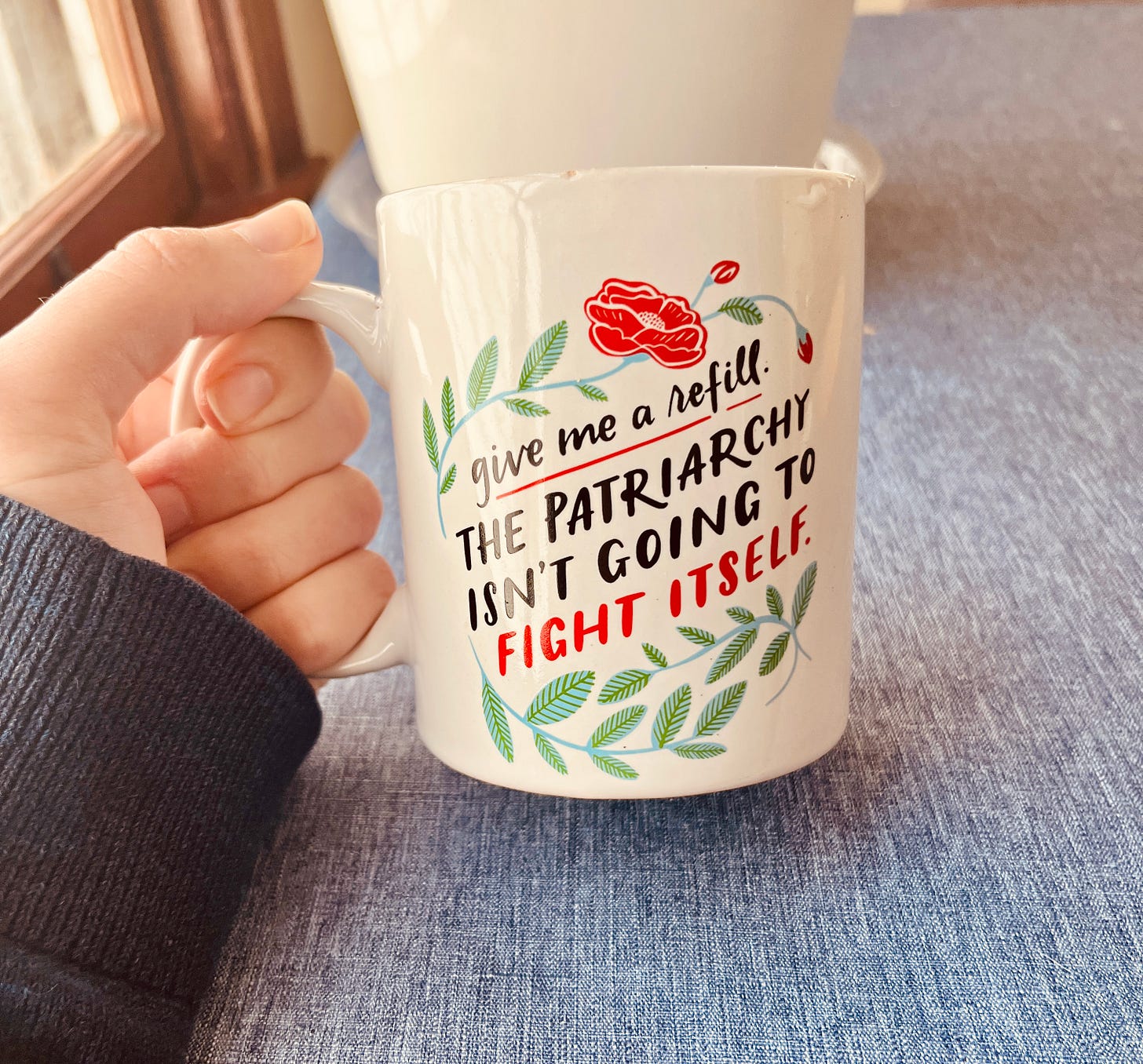My favorite mug, a gift from (ironically?) my husband, reads: “Give me a refill. The patriarchy isn’t going to fight itself.” Most mornings when I reach into the cupboard, I’m too groggy to notice what I’m drinking out of, let alone contemplate its deeper political resonance. Occasionally, though, when my motivation is at its lowest ebb, that cheesy little mug inspires me to buckle down and get to work. I’m not just slogging through a paper draft, I’m uncovering and naming structures of patriarchal oppression!
But it's one thing to “fight the patriarchy” when the patriarchy exists somewhere vaguely out there in the ether. What happens when you realize the patriarchy is sleeping beside you at night and sitting across from you at the dinner table? What do you stand to lose and to gain by smashing the patriarchy in your own home?
This is the question one of my favorite cartoonists, Liana Finck, posed in a recent op-ed (NYT gift link) with the beguiling title, “I Quit the Patriarchy and Rescued My Marriage.” In the cartoon, Finck depicts a gradual souring of her marriage, catalyzed by the birth of her first child. Her chief complaints will be familiar to readers of this newsletter: “Why, when daycare calls, are you always the one who scraps her workday and upends her schedule? Why, when you come home from a rare evening away, do you always return to a [home] in chaos?”1
Finck’s diagnosis of the problem is clear: patriarchy. But when she names the issue for herself and subsequently confronts her husband with it, her situation gets worse rather than better. He tunes out, she gets pissed, she confronts him again, and actual change in their labor allocation comes to seem farther and farther out of reach.
Finck’s dilemma strongly echoes that of journalist Olga Khazan, whose story I wrote about a few weeks back. To refresh your memory: despite performing all the “best practices” experts say will help you equalize household labor, Khazan couldn’t get her husband to step up and share in the cognitive load. Khazan, like Finck, was angry. And like Finck, Khazan found that her anger seemed to get her nowhere.
It took me a thousand words or so to explain this as a classic case of rock-versus-hard-place: two bad options, which do you choose? Living up to the old adage, Finck only needed one picture:

Either end the marriage or find a way to live with the inequality, preferably without driving yourself mad in the process. Finck and Khazan both choose door #2, but from slightly different angles.
To explain, allow me a brief digression into the realm of psychology. Perhaps you’ve heard of cognitive dissonance? It’s the uncomfortable sensation that arises when you recognize a conflict between your identity/beliefs and your behavior/situation. In this case:
Belief: I am a feminist committed to gender equality.
Behavior: I am tolerating patriarchal inequality in my own marriage.
Cognitive dissonance is quite uncomfortable, to the point where most of us seek out some sort of resolution. That might mean changing your beliefs (I guess I’m not all that committed to gender equity) or changing your behavior (I will no longer accept my husband’s minimal participation as sufficient).
Both Khazan and Finck start out by changing their behavior: they get mad and call their spouse out for his subpar contributions. But each quickly finds that this doesn’t accomplish much. They’re still stressed and still overwhelmed with household responsibilities, but they’re also less happy to boot.
So, they pivot to a third approach for resolving cognitive dissonance: reframe the situation to remove the (appearance of) conflict between belief and behavior. For her part, Khazan continues to acknowledge the inequality but reframes it as a necessary evil. Given the world in which she and her husband live, and given that (for her) raising a toddler with an imperfect co-parent is preferable to raising a toddler alone, Khazan decides that accepting some level of gender inequality is the best she can do. Put another way, she continues to see patriarchy at work in her relationship, but she makes a mindful choice to live with it.
Finck, on the other hand, reframes by working hard to un-see patriarchy. Her husband, she writes, is “a specific person, one with problems he might not know how to solve.” In this case, Finck’s husband self-diagnoses with an unnamed condition. (She omits the specifics to protect his privacy, but given the context, it seems likely to be some mental health issue or neurodivergence (e.g., depression or ADHD).)
This new piece of information allows Finck to recast her spouse as a struggling man, rather than an instantiation of patriarchal oppression. Maybe he “isn’t doing as much as he should…[but] maybe he wants to. Maybe, with your support, he’ll learn how.” The cartoon ends on a wistful but optimistic note. Marriage has changed Finck in unexpected ways, she acknowledges. Yet she’s hopeful that abandoning her desire to call out gender inequality as such will, paradoxically, help her and her husband shift their dynamic:

What’s the lesson here? My goal is not to pass judgment on Khazan or Finck or anyone else who finds herself in a similar position. (I’m sure both women have gotten more than their fair share of critical emails.)
Nor am I endorsing the strategy of reframing, per se. Feminist anger can be a powerful driver of social change, as philosopher Kate Manne compellingly argues. Smashing the patriarchy will inevitably involve some degree of individual and marital disruption and discomfort.
Instead, in highlighting these two examples, my hope is to show how even experiences we feel as deeply personal—like a fight with our spouse—are often manifestations of much broader social patterns. Dilemmas like Khazan’s and Finck’s come up over and over again in my interviews with couples about mental labor. And, like Khazan and Finck, many of my interviewees turn to reframing to resolve their cognitive dissonance.
Perhaps you, too, are stuck in a similar bind? If so, I hope these stories make you feel less alone, and less inclined to blame yourself for your predicament. “The patriarchy” is a vast, many-tentacled system that both you and your partner are caught within. Naming our challenges and situating them within that vast system will (I hope!) help us find collective ways to navigate the perils of contemporary different-gender relationships, leaving far fewer individual women to struggle in isolation.
Now, time for that refill…
Call for reader stories!
On another note, Finck’s mention of her husband’s diagnosis reminded me of a topic I’ve long been meaning to write about: how do couples navigate the mental load when one partner is neurodivergent?
I’d love to hear from readers. DM me or reply to this email and tell me:
What’s your situation? Who do you live with, and what neurodivergence do they (or you) experience?
What challenges (or advantages!) does this present for how you manage cognitive and emotional labor in your household?
What solutions, strategies, or workarounds have you tried? How effective are they?
I’m happy to keep your message anonymous! Thanks in advance for sharing your story.
Finck actually calls it a castle, playing on the trope of the fairy tale romance throughout the cartoon.







I’ve thought a lot about that drawing with the two lines headed in the same direction and was like…”actually it looks like one line (me) so far ahead as a result of having become a parent and taken on that challenge and the other line (him) so god damn behind.” How can you not be angry about that?! I don’t know if it’s as easily named as the patriarchy. I’m much more comfortable now using the word misogyny because this expectation that women carry the load, when the load is their husband, is so harmful and patriarchy can seem kind of abstract, or like you said in the first case, just something we live with.